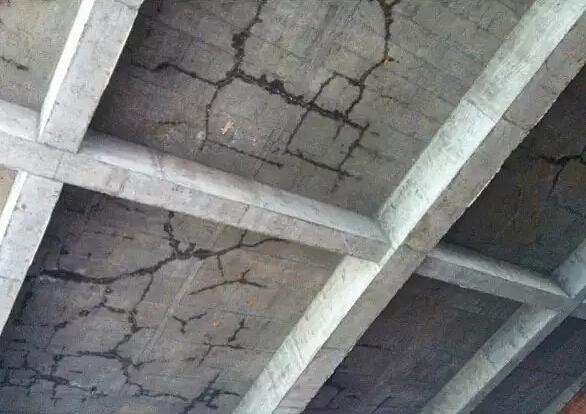The roof mortar cracking reasons and repair solutions
Author:ANT CONSTRUCTIONS Comefrom: Createdate:2020/10/29 17:12:32 Hits:862
The roof mortar cracking reasons and repair solutions

Under normal circumstances, the cracks on the floor and roof are surface cracks, longitudinal cracks, horizontal cracks and diagonal cracks. The main reasons are construction method and concrete raw materials. The following will analyze them one by one.
Crack reasons of mortar
Main reason of mortar cracks
1. First of all, the main reason for roof cracks is the quality of concrete raw materials. Cement coagulation or expansion is abnormal, such as cement stability is unstable, cement contains quicklime or magnesium oxide, these components have expansion after being hydrated and cause cracks. If there is too much mud in the aggregate, as the concrete dries, irregular network cracks will occur. Alkali-aggregate reaction: Alkaline aggregates such as protein, andesite, basalt, diabase, phyllite, etc. may react chemically with highly alkaline cement to form an alkali-silica gel with swelling ability which cause concrete expansion and destruction, and cracks. The water-cement ratio, slump is too large, or the coagulation with excessive silt sand is very sensitive to the change of the water-cement ratio, which is basically the superposition of the influence of water and cement measurement changes on the strength. Therefore, the measurement deviation of the admixture solution of water, cement, and extravasation mixed materials will directly affect the strength of concrete. However, the concrete prepared with silt with large mud content has large shrinkage, low tensile strength, and it happen cracks due to plastic shrinkage. In order to meet the pumping conditions, the pumped concrete has large slump, good fluidity, and local coarseness. The phenomenon of less aggregate and more mortar will cause surface cracks when concrete is dehydrated and shrinks.
Direct reason of mortar cracks
2. In addition, the construction quality of the roof is the direct reason of cracks.
The concrete construction is over vibrated, the formwork and the cushion layer are too dry, after the concrete is poured and vibrated, the coarse aggregate settles and squeezes out the moisture and air, the surface occurs bleeding to form a vertical volume reduction settlement, this causing the surface mortar layer larger shriankage than the lower concrete layer, after the water evaporates, it is easy to form condensation cracks.
If the formwork and cushion layer are not sprinkled in pouring and coagulation and they are too dry, the formwork will absorb a lot water, this causing plastic shrinkage of the concrete and cracks.
Excessive scratch drying and calendering of the concrete after pouring will cause the fine aggregates floating on the surface too much and forming a cement slurry layer with a lot water content. The calcium hydroxide in the cement slurry reacts with carbon dioxide in the air to form calcium carbonate, this causing the surface carbohydrate shrinks, causing the surface of the concrete slab crackS.
Caused by improper construction technology during the construction process, due to improper construction technology, the negative reinforcement at the support sinks, the protective layer is too large, and the fixed support becomes a plastic hinge support, causing cracks in the upper part of the slab along the beam support;
In the construction of elastic deformation and negative bending moment at the support, the concrete does not reach the specified strength, the mold is removed prematurely, or the load is loaded before the concrete reaches the final setting time resulting in elastic deformation of the concrete floor, resulting in low or no early concrete strength, it will bear bending, compressive, and tensile stresses, which will cause internal damage or fracture of the floor; the uneven settlement of the floor slab on both sides of the beam will also cause the support to produce a negative dome moment and cause transverse cracks.
Board surface cracks caused by inadvertent construction of post-cast belts: In order to solve the shrinkage deformation and temperature stress of reinforced concrete, the specification requires the use of post-construction casting belt method. Some post-construction belts are not constructed according to the design requirements, for example, no gaps are left in the construction. Cracks will be happen; the post-pouring belt of the slab does not support the formwork, causing slope rubbing; loose concrete is not completely removed, etc., which may cause cracks on the slab surface.
The concealed water pipes and wire casings laid in the floor cushion are improperly laid, such as the laying of water pipes and wire casings is not firm enough, concentrated laying, and overlapped up and down, causing the water pipes and wire casings to be covered within 1/3 of the thickness of the cushion. Insufficient thickness of the protective layer may cause cracks along the length of the pipeline.
Concrete shrinkage (temperature cracks): It is well known that the reason for the shrinkage of concrete is mainly due to the hydration of cement in the early stage of hardening, forming a new cement crystal. This crystal compound is smaller than the raw material, this causes the volume of concrete shrinkage, the so-called condensation is mainly caused by the evaporation of free water in the concrete (stone texture paint) in the later stage. Moreover, if the concrete is in an environment with a large temperature difference, it will shrink more.
If the construction takes place under the hot summer temperature, the temperature of the gravel surface will increase, which will cause the volume of the gravel to expand. After mixing into concrete, the gravel will shrink under cold weather which causing hairline cracks on the surface of the concrete;
After the concrete is poured, the concrete is not watered and cured in time. At higher temperatures, water loss shrinks, the release of hydration heat is large, and the water is not replenished in time. Therefore, during the hardening process, the cast-in slab is restrained by the support, which is bound to produce temperature stress and cracks. Cracks are also first generated in the weaker parts, namely the corners of the board.
In addition, the temperature big difference between indoor and outdoor will cause certain cracks.
At present, in the construction process of the main structure, there is a big contradiction between quality and construction period. Generally, the construction speed of the main structure is about 5-7 days for one floor averagely, some project even less than 5 days. Therefore, when the curing time of the floor concrete is less than 24 hours after the completion of the concrete pouring, the construction activities such as steel tying and material lifting are busy, which makes the rooms in the large bay area worse.
In addition to the disadvantages that the total shrinkage of the concrete with large bays is smaller, the bays are larger, and it is easier to cause irregular stress cracks due to the impact of material lifting and unloading under the condition of insufficient strength. And once these cracks are formed, it is difficult to close and form permanent cracks.
How should we take preventive and remedial measures for cracks on the roof of the house?
First of all, although the reinforced concrete cast-in slab has a major defect of cracks in the process, compared with the precast slab, it has more advantages, and its disadvantage can be overcomed through certain measures. The advantages of cast-in-place slabs are mainly manifested in structural performance. After the use of cast-in-situ slabs, the structural rigidity and strength of buildings and roofs, and the overall seismic performance of buildings will be significantly improved. For the cracks of cast-in-situ slabs, the following measures can be taken to reduce or avoid these cracks:
Before the concrete is poured, the base layer and the formwork should be soaked with water to avoid excessive absorption of water. During the pouring process, try to achieve sufficient vibration and avoid excessive.
After the concrete floor is poured, the surface scraping should be limited to a minimum to prevent the dry cement from being sprayed on the concrete surface and strengthen the early curing of the concrete. After the floor slab is poured, the surface of the slab should be covered with materials, insulated in time, and carefully maintained to prevent strong wind and hot sun exposure
Strict construction operation procedures, do not rush to work blindly. Prevent premature upload, load and premature demoulding. In the process of floor slab pouring and pounding, special personnel should be sent to protect the ribs to avoid the phenomenon of negative ribs stepping on the curved surface. By arranging long steel meshes in the surface layers on both sides of the girder, it can withstand the negative bending moment of the support and avoid cracks caused by uneven settlement.
The construction of the post-construction pouring zone should carefully understand the design intent, formulate a construction plan, and prevent inconsistency of concrete at the post-pouring place, gaps and gaps not in accordance with the drawings, and bending of steel bars during construction. At the same time, it is also necessary to prevent the removal of part of the formwork and pillars before the concrete is poured which will cause the beams and plates to form a cantilever and cause deformation.
For thicker line pipes or the collection and distribution of multiple line pipes, a short anti-cracking steel mesh perpendicular to the line can be added. The short anti-cracking steel bars adopt Φ6-Φ8, the spacing is ≤150, and the anchorage length difference at both ends should be less than 300 mm.
Before erecting the formwork support frame of the temporary large bay area material hoisting and unloading area in the plan, it is considered in advance to use dense poles and joists to increase the rigidity of the formwork support frame to enhance the rigidity and reduce the deformation. Strengthen the resistance to shock and vibration loads in this area, and lay old wooden molds on the newly built concrete surface in this area to protect and spread the stress to further prevent the occurrence of cracks.
More maintenance of floor concrete: The moisturizing maintenance of concrete is very important for its strength growth and various performance enhancements. In particular, early proper maintenance can avoid surface dehydration and greatly reduce the occurrence of initial expansion and contraction cracks. However, in actual construction, due to rushing to the construction period and watering will affect the spring line and construction personnel's operation, the floor concrete often lacks sufficient and sufficient watering and maintenance duration. For this reason, during construction, it is necessary to insist on covering sacks or straw bales for proper moisturizing and curing for about a week, and spray curing liquid can be used for curing to reduce costs and improve work efficiency, and avoid or reduce the impact on construction.
Strictly control the thickness of the protective layer of the negative reinforcement of the slab surface: the negative reinforcement of the cast-in-situ slab is generally placed on the supporting beam reinforcement, and should be tied together with the beam reinforcement; in addition, measures such as iron racks or concrete pads are used to fix the negative reinforcement The position of the steel plate ensures that the steel bars on the board will not sink during the construction process, so that the protective layer can be effectively controlled to avoid cracks caused by the sinking of the negative ribs and the thickening of the protective layer at the support. 1.5cm.
Remedy for roof cracks

For cracks on the surface of general concrete floor slabs, the cracks can be cleaned first, and then filled with epoxy grout or sealed with surface painting after drying. If cracks are found before the final setting during construction, they can be wiped and pressed again.
For other general crack treatment, after cleaning the board seam, use 1:2 or 1:l cement mortar to flatten the sock seam for maintenance.
When the crack is large, the eight-shaped groove should be cut along the crack. After washing it, use 1:2 cement mortar to smooth it, or use epoxy cement to fill it
When the crack area of the floor is large, static load test should be carried out on the floor to check its structural safety. If necessary, a layer of steel mesh can be added to the floor to improve the integrity of the slab.
For dangerous structural cracks that are long and penetrating, and the width of the crack is greater than 0.3mm, structural adhesive flat steel can be used for reinforcement, and the joints of the plates can be filled with high-pressure glue.








